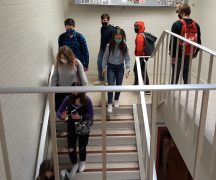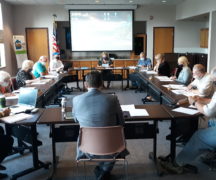By JAN LARSON McLAUGHLIN
BG Independent News
A shift in COVID strategy is replacing much of contact tracing with personal responsibility.
For nearly two years, health departments have been scrambling to keep up with contact tracing of new COVID cases. But the practice is no longer effective, and health departments are being advised to instead focus on outbreaks and more targeted case investigations involving vulnerable populations.
“As the pandemic has evolved, we want to direct resources to the best uses,” Wood County Health Commissioner Ben Robison said Monday afternoon. “We want to focus public health strategies on the most effective policies.”
Due to the shorter incubation period of the Omicron variant, only a very small portion of total cases and close contacts are being reached by public health contact tracers in time to prevent onward transmission.
Nationwide, public health is being asked to switch gears. Evidence of that locally is the “COVID self-help resources” box for people to click on the Wood County Health Department site: https://sites.google.com/view/wchdohio-coronavirus.
The self-help resources are intended to help people navigate the virus without direct contact from the health department. The resources box information is expected to be expanded in the future.
“We built this to answer questions in a very straightforward manner,” Robison said. “We want to empower individuals to make decisions that will protect them. We want to equip people to make good decisions.”
The self-help advice is the same as that given by contact tracers – on isolating from others, on who should be made aware of possible exposure, on the best types of masks to wear, on vaccines and boosters, and on COVID tests and therapeutics.
“We knew this was something coming in this pandemic response,” Robison said. “The pandemic is still with us. We need people to take these steps individually.”
Most local school districts have already announced that contact tracing efforts have been halted.
Contact tracing through the health department will still be done in a limited manner if there is an outbreak or if cases involve vulnerable populations such as in a nursing home.
“Something where early intervention will help down the road,” Robison explained.
Cases dropping
The latest COVID case numbers in Wood County show a sharp drop.
The total new cases reported in the last seven days in the county were 908. That compares to 2,713 reported for the week prior to Jan. 20.
“Our cases are falling really fast,” Robison said Monday afternoon. “Things are certainly headed in the right direction.”
But the downward trajectory has been seen before – only to be followed by an increase.
“That doesn’t mean we won’t see a blip up,” he said. “As we turn the corner, we do expect we’ll see another surge in the next couple weeks.”
Changing stats format
For the better part of two years, the Wood County Health Department has been reporting updates on local COVID cases, deaths and hospitalizations on every Monday and Thursday.
Recently, the health department changed its statistical reporting so it aligns with the state’s. Instead of reporting new numbers for every three or four days, the numbers will span two weeks, with some daily updates. There will be some lag time.
The stats show six deaths from COVID being reported last week (though that doesn’t mean they occurred last week.) The average age of the deceased was 64.
Between Jan. 6 and 20, Wood County recorded 71 hospitalizations due to COVID, with the average age being 62. The age range for those hospitalized for COVID was 10-96.
The new statistics that can be found at https://sites.google.com/view/wchdohio-coronavirus, also show specifics for age groups. For example, the number of COVID cases among those 19 and younger is greater than in the past. The cases among those aged 20-39 were a much larger percentage of those age ranges than other ages. That coincides with lower rates of vaccination among those ages, Robison said.
Importance of boosters
The more detailed statistics about local COVID cases emphasize the value of following up the first two shots with the booster, Robison said.
“If you haven’t got your booster, you’re missing out on the protection,” he said. “The benefit is the greatest for those who have completed their vaccines.”
People who have received the booster shot may be inconvenienced by COVID, but they are far less likely to have severe symptoms.
“It mitigates the impact of the disease if you become sick,” Robison said.
“We’re going to be focusing on increasing boosters,” he said.
National shift from contact tracing
Following is information issued for national public health agencies about contact tracing:
Although universal case investigation and contact tracing was implemented in the spring of 2020 to slow COVID-19 transmission, much has changed over the past year prompting the need for a revised public health approach. This includes the wide availability of vaccines, better understanding of the epidemiology of the virus, and the emergence of the more infectious Omicron variant.
While universal case investigation and contact tracing during the initial phase of the pandemic was justified in the attempt to contain the pandemic, most experts in public health agree this is no longer optimal.
Many states and localities have already scaled back or stopped universal case investigation and contact tracing for COVID-19. A number of scientific and other factors reduce the utility and feasibility of universal case investigation and contact tracing for each COVID-19 case.
These factors include:
- The large number of asymptomatic and less severe cases. This is due to changes in the virus and widespread vaccination in the U.S.
- Many infections are never identified by public health agencies because people with asymptomatic or mild cases may not get tested, as well as the increasing use of “over the counter” at-home tests, which are generally not reported to public health agencies.
- The highest risk of transmission to others occurring prior to symptom onset and during the first few days of symptomatic illness (or immediately after first testing positive for those who remain asymptomatic).
- The shorter incubation period of the Omicron variant.
Consequently, only a very small portion of total cases and close contacts are being reached by public health contact tracers in time to prevent onward transmission.
Therefore, it is appropriate for public health agencies to transition resources into more effective strategies to lessen the impact of COVID-19 by focusing surveillance and prevention efforts on the most severe outcomes of COVID-19: hospitalizations and deaths. .
Moving forward key public health strategies should include:
- Increasing the number of people who are up to date with their COVID-19 vaccinations, including booster doses, especially for those at higher risk for severe outcomes.
- Strong messaging about the importance of effective mask wearing, especially now during times of increased community transmission.
- Targeting prevention strategies to the most vulnerable people, populations, and settings, including testing, distribution of higher quality masks, and early access to antivirals and monoclonal antibody treatments.
- Availability of testing to support treatment, as a risk mitigation strategy in congregate residential settings, and individual use to identify their risk of transmission and isolate appropriately.
- Conducting outbreak investigations and targeted case investigations as necessary to prevent or understand disease transmission in high-risk settings, or among those with more severe illness or unusual illness presentations.
- Instituting and improving environmental measures to reduce indoor aerosol transmission of pathogens (e.g., improving indoor air quality through ventilation, filtration, and/or other technologies; and advocating for more formal indoor quality air standards).
It is time to empower the public to act when they suspect COVID-19 infection. If an individual suspects COVID-19 infection, they should seek testing, stay home to prevent transmission to others, rapidly notify close contacts of their exposure, and seek healthcare to facilitate access to medical treatment if they are at higher risk for severe outcomes.
This information can be provided through methods that may be more likely to reach the public than standard public health contact tracing, including information provided at the time of testing (e.g., educational inserts provided with home test kits) and leveraging automated text/call systems (such as exposure notification systems) that are able to reach out to people to alert them to their status and give general guidance. It remains critical to provide access to resources if needed for the public to safely isolate away from others.
Although it is no longer optimal for public health to universally investigate and monitor individual COVID-19 cases and their contacts, contact tracing remains a necessary public health tool for interrupting ongoing transmission of COVID-19 and preventing disease in the most vulnerable populations, especially in certain higher risk congregate residential settings (shelters, correctional facilities, and nursing homes) or in other specific situations, such as outbreak investigations or if warranted based on concerning changes in the clinical or epidemiological characteristics of the virus.
Individual jurisdictions may also consider continuing contact tracing in other settings, including schools and child-care centers, depending on local context, priorities, and available resources. Public health will continue to evaluate the optimal control strategies for COVID as the response evolves and make strategic changes to prevent or reduce transmission.





